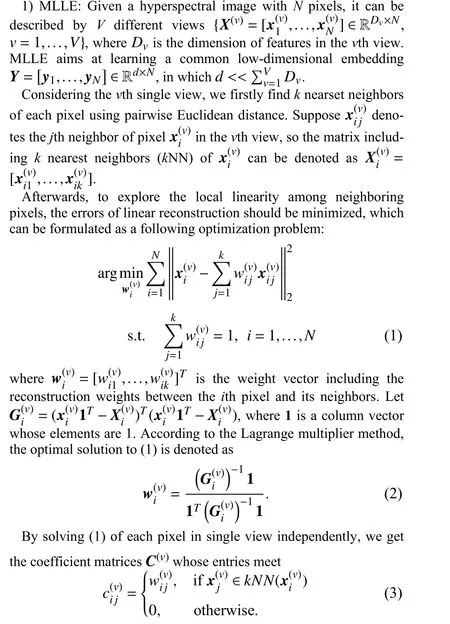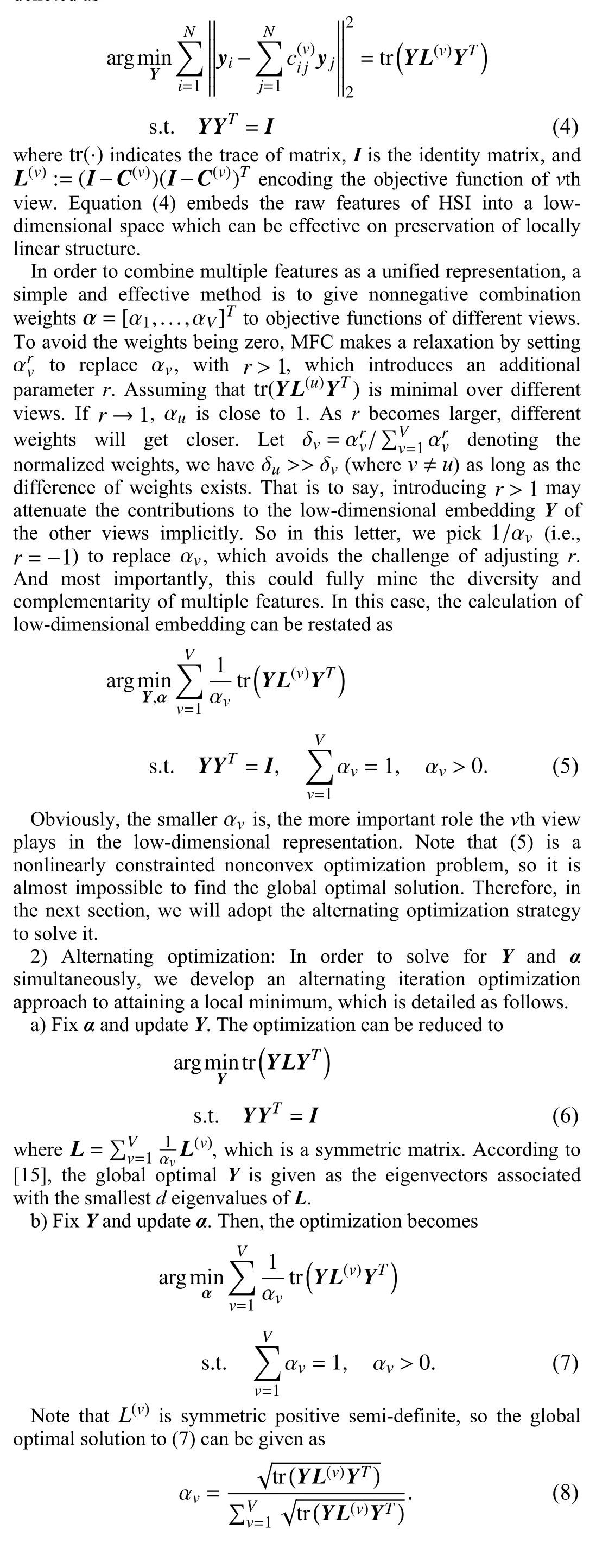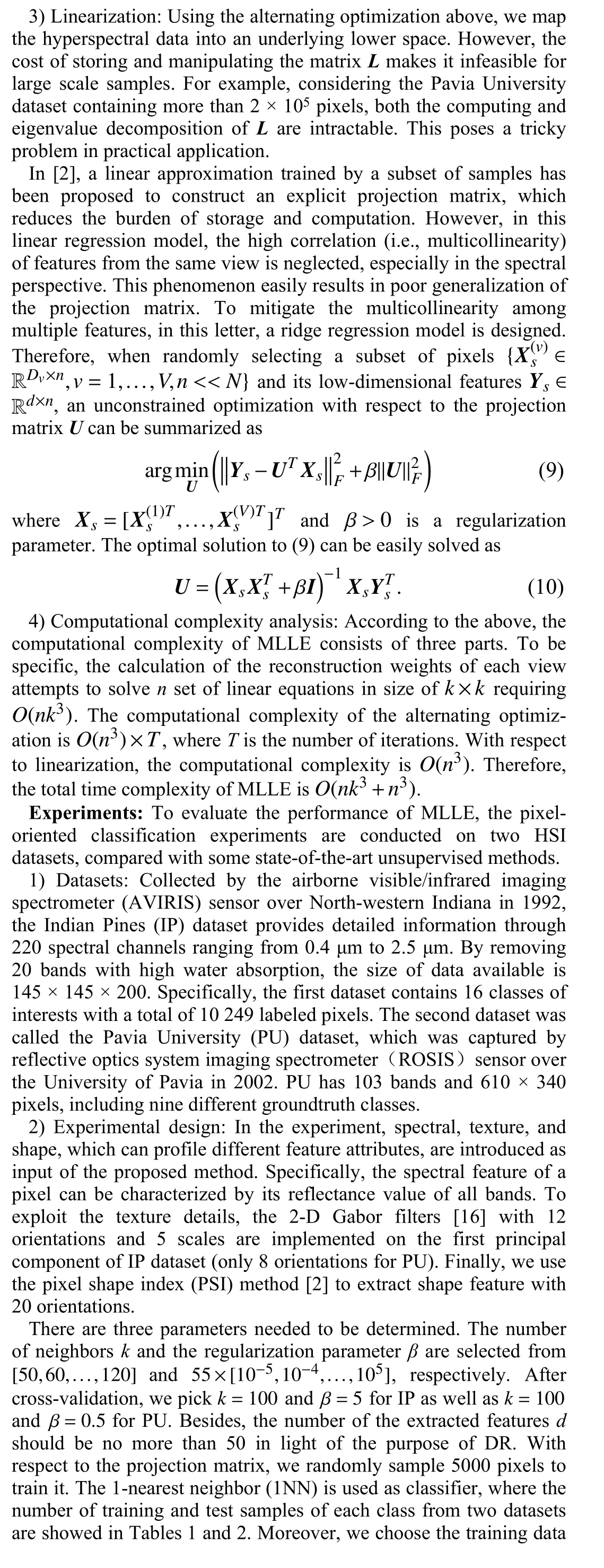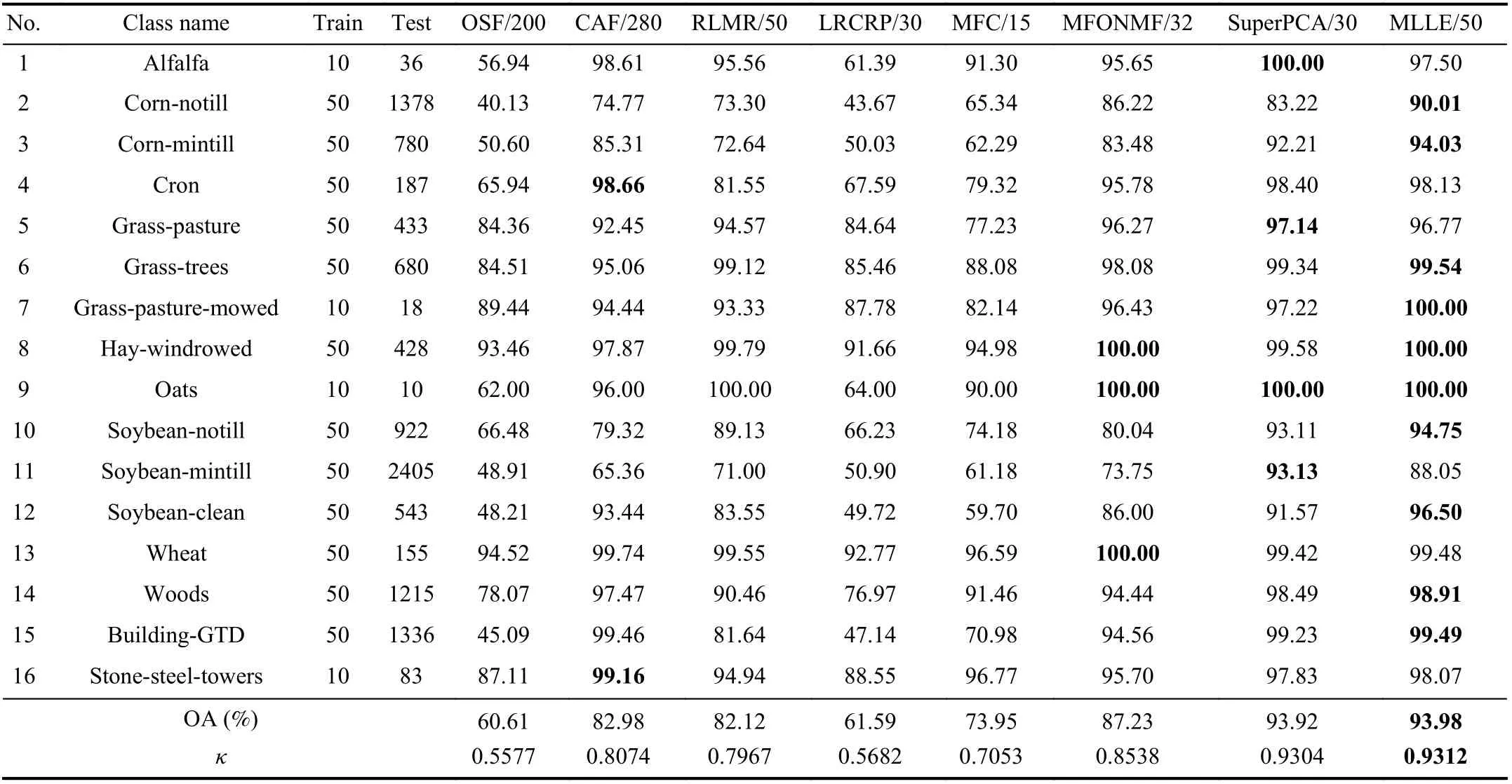Multiview Locally Linear Embedding for Spectral-Spatial Dimensionality Reduction of Hyperspectral Imagery
2022-06-25HaochenJiandZongyuZuo
Haochen Ji and Zongyu Zuo,
Dear Editor,
Dimensionality reduction (DR) plays a prominent role in the processing of hyperspectral imagery. Considering the high dimensionality of multiple features, this letter presents a new unsupervised DR method named multiview locally linear embedding(MLLE), which captures the local linearity and global nonlinearity of the data sufficiently. We formulate MLLE as an optimization problem, where the diversity and complementarity of multiple features is fully exploited. An effective alternating optimization scheme is derived, and a linear model based on ridge regression is extended to alleviate the high correlation among single-view features.Experimental results on the Indian Pines and Pavia University datasets demonstrate the superiority of our proposed MLLE.
Introduction: Hyperspectral imaging, as an emerging technology in the field of remote sensing, makes it possible to collect data about spectral channels and spatial pattern of ground objects simultaneously [1]. Any pixel of hyperspectral imagery (HSI) can be represented by different views [2], e.g., spectral, texture, and shape,providing detailed and complementary information on a variety of applications especially in classification. Nevertheless, the high dimension of multiple features also introduces several difficulties,such as the computational burden and the Hughes phenomenon [3].Therefore, it is necessary to reduce the dimensionality of HSI, which learns a common low-dimensional embedding of different views.
Over the past decades, various unsupervised DR methods, which can be categorized into feature selection and feature extraction (FE),have been proposed for HSI. This letter will focus on unsupervised FE. Instead of conventional linear technique [4], manifold learningbased methods aim to explore the nonlinear structure of HSI,including Isomap [5], locally linear embedding (LLE) [6], Laplacian eigenmaps (LE) [7], etc. In [8], a local manifold learning is proposed for hyperspectral DR, which obtains a discriminative lowdimensional embedding. To enhance the aggregation of the data, the work [9] models the scatter information and the dual graph structure of HSI. Additionally, Laplacian regularized collaborative representation projection (LRCRP) [10] attempts to preserve the local manifold structure fully, by adding Laplacian regularization and local enhancement into the collaborative representation projection.However, these methods are merely designed for spectral signatures,and concatenating features from different views as a new vector serves no practical purpose.
To conquer the aforementioned difficulties, a multiple features combining (MFC) framework [2] is presented, which learns a unified low-dimensional representation successfully. Afterwards, [11]investigates an unsupervised approach which incorporates multiple features into orthogonal nonnegative matrix factorization (ONMF)for effective DR. Rather than utilizing the spatial feature directly, a novel FE approach based on superpixelwise principal component analysis (SuperPCA) is proposed in [12], which performs PCA on various homogeneous regions.
Among all these methods, the MFC framework grabs our attention.Firstly, MFC constructs the weight matrix of each single view separately based on LE. Then, the objective functions of different views are incorporated as a unified one. By optimizing a set of combination weights, a unified low-dimensional embedding is obtained. Although the framework has proven to be effective in [2],[13], [14], the heat kernels in the weight matrices of all views are artificially designed, leading to relatively weak representation of local manifold without exploiting the natural property of local neighbors. Besides, when coping with the out-of-samples problem,the linear version of MFC neglects the multicollinearity of features in single view, particularly in the spectral domain. Therefore, in this letter, we propose a new unsupervised DR method named MLLE.Specifically, MLLE explores and models the manifold structure of different observation spaces assuming local linearity. To fully exploit the complementary information of various views, we use the reciprocal of the combination weights to determine the contribution of each view. Moreover, we have further extended to a new linear model based on the ridge regression. Finally, experimental study verifies the effectiveness of the proposed method. Compared to MFC, the classification performance of MLLE is significantly improved, even comparable to those of state-of-the-art techniques.
Proposed method:

LLE says that in a low-dimensional space, the linear combination between each original feature and its neighbors should be preserved.Therefore, the goal of linear embedding in single view can be denoted as



Table 1.Number of Samples as well as Classification Accuracy of Various Methods Using 1NN on IP

Table 2.Number of Samples as well as Classification Accuracy of Various Methods Using 1NN on PU

To validate the effectiveness of the proposed MLLE, we compare the classification performance with original spectral feature (OSF),the concatenation of all features (CAF), two state-of-the-art spectral DR techniques (a robust local manifold representation (RLMR) [8]and LRCRP [10]), and three state-of-the-art spectral-spatial DR methods (MFC [2], multiple-features ONMF (MFONMF) [11] and SuperPCA [12]).
3) Experimental results: The accuracy of each class, overall accuracy (OA), and kappa coefficient (κ) of different methods under the optimal parameters for IP are illustrated in Table 1 clearly, where the numbers in the first line are the final dimensions of corresponding DR methods. From this table, we arrive at some conclusions. Firstly,for the two spectral-based DR methods, the improvement of classification performance is limited without considering spatial information. And unfortunately, MFC framework cannot exploit the multiple features effectively on IP dataset, whose accuracy is significantly lower than MFONMF, SuperPCA and MLLE. Finally,the proposed MLLE outperforms the other methods, with highest OA andκas well as highest accuracy of ten categories.
Also, the observations, which reveal the classification accuracy of different methods using 1NN on PU dataset, are illustrated in Table 2.As we can see, SuperPCA performs best, and the proposed MLLE can achieve the optimized goal of using the fewest dimensions to yield the second best accuracy, followed by MFONMF, RLMR,LRCRP, OSF, CAF and MFC.
Fig. 1(a) shows how the objective function value of MLLE changes as the iteration number increases, which proves a fast convergence speed. We now observeαandδof each feature with respect torfrom Table 3. Obviously, whenr=-1, the complementary nature of different features can be explored in an effective manner in ways thatr>1 cannot match. Additionally, we compare the OA of the proposed scheme (MLLE-Ridge) to those of MLLE with full samples (MLLE-Full) and linear regression (MLLELinear). The OA curves versus the dimensiondon IP dataset are displayed in Fig. 1(b). It is shown that the proposed scheme has obvious predominant in accuracy, which lies in the mitigation of the highly correlated features.
Conclusion: In this letter, we propose a new unsupervised DR framework for HSI based on MLLE. Not only does the framework apply LLE to preserve the locally linear structure of each single view, but it also learns a unified and sufficiently discriminative representation over multiple views. As an extension of MFC, the proposed MLLE alleviates the multicollinearity in the out-of-sample problem. Experimental study on two benchmark datasets demonstrates the effectiveness of the proposed MLLE.

Fig. 1. Performance validation. (a) Convergence of MLLE on two datasets;(b) Classification results of full samples MLLE and two linear versions using 1NN on IP.

Table 3.Weights and Performance Comparison of MLLE With Different r on PU (d =15)
Acknowledgments: This work was supported by the National Natural Science Foundation of China (62073019).
杂志排行
IEEE/CAA Journal of Automatica Sinica的其它文章
- Exponential Continuous Non-Parametric Neural Identifier With Predefined Convergence Velocity
- Exploring Image Generation for UAV Change Detection
- Wearable Robots for Human Underwater Movement Ability Enhancement: A Survey
- A Scalable Adaptive Approach to Multi-Vehicle Formation Control with Obstacle Avoidance
- Fuzzy Set-Membership Filtering for Discrete-Time Nonlinear Systems
- Distributed Fault-Tolerant Consensus Tracking of Multi-Agent Systems Under Cyber-Attacks
